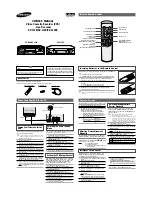
GRUNDIG Servicetechnik
2 - 5
GV470S…
Beschreibungen / Descriptions
2.1.1 Reset / Netzteilansteuerung
Nach dem Anstecken des Recorders ans Netz erhält der Ablaufrech-
ner an IC7060-(29) den Resetimpuls RESET , der vom Netzteil erzeugt
wird. Nach der Initialisierung gibt der Ablaufrechner über den seriellen
Bus zur Port-Erweiterung am Schieberegister IC7020-(4) die Funktions-
span12V
F
und +5V
F
(Netzteil – IC7190) frei, um das Laufwerk
in die Position "Stop" oder "Cassettenauswurf" zu bringen.
Des weiteren wird an IC7020-(14) der RESET -B-Impuls ausgegeben,
den man über Steckerkontakt 1510-(4) der Bedieneinheit zuführt.
2.1.2 Steuerung des Fädelmotors
(Cassettenschacht / Fädelmechanik)
Der Antrieb der Cassettenschacht- und Fädelmechanik erfolgt über
den Fädelmotor. Zur Ansteuerung des Fädelmotors wird im
Widerstandsnetzwerk R3140…R3143 das Digital-Signal, das vom
Ablaufrechner IC7060 über einen seriellen Datenbus zum Schiebe-
register IC7100 gelangt, in ein Analog-Steuersignal gewandelt. Mit
diesem steuert man über den Fädelmotor-Treiber IC7110-(6), -(7) /
-(1), -(3) und Steckerkontakt 1508-(1), -(3) den Fädelmotor.
Die Laufwerksposition erkennt der
µ
C durch das Zählen der Fädelta-
choimpulse (FTA) in Verbindung mit dem Schalter INIT sowie der
Kennung des "TS" Bandanfangs sowie "TE" Bandendes. Die Fädelta-
choimpulse (FTA) werden dem
µ
C über Steckerkontakt 1502-(6) und
IC7070-(8), -(14) zugeführt. Das Laufwerk enthält je einen Schalter zur
Initialisierung des Fädeltachos (INIT), für die Löschsicherung (
REC
)
und zur Kennung der S-VHS-Cassette (SVHS). Die Spannungen
entsprechend der Schaltzustände verkoppelt man über die Stecker-
kontakte 1502-(1), -(3), -(7), R3174 (S-VHS), R3173 (INIT) sowie
R3172 (
REC
) und führt diese dem IC7060-(25) zu.
Der angehobene Cassettenschacht ist mechanisch mit dem Fädelta-
chogeber (Flügelrad) verbunden. Beim Einschieben einer Cassette in
den Cassettenschacht muß diese soweit eingeschoben werden, bis
drei Fädeltachoimpulse erzeugt wurden. Danach aktiviert der
Ablaufrechner den Fädelmotor und übernimmt somit das Laden der
Cassette.
Beim Auswurf (Eject) der Cassette werden kurz vor Erreichen der
Endposition des Cassettenschachtes die Empfänger für Bandanfang-
und Bandende-Kennung gleichzeitig freigegeben. Kurze Zeit später
schaltet der Ablaufrechner automatisch den Fädelmotor ab.
2.1.3 Wickeltachoimpulsverarbeitung
Die Optokoppler am linken und rechten Wickelteller (WT1 / WT2)
geben pro Umdrehung des Wickels 8 Impulse ab. Diese werden im
IC7070 (Pins 6/9 –> Pins 17/12) in Rechteckimpulse umgeformt und
dem IC7060-(7), -(8) zugeführt. Dieser errechnet aus dem Verhältnis
der beiden Frequenzen den augenblicklichen Bandstand und die
Gesamtlänge der Cassette.
2.1.4 Bandanfang-/ Bandende-Erkennung
Zur Erkennung von Bandanfang und Bandende hat die VHS-Cassette
an den beiden Bandenden eine Klarsichtfolie von 13…19cm Länge.
Über 2 Optokoppler wird Bandanfang und Bandende erkannt. Die über
T7105 getaktete Sendediode taucht dabei in der Cassettenmitte in ein
Loch ein. Die Empfänger sind links und rechts außerhalb der Cassette
angeordnet.
Die Phototransistoren "TS" (Bandanfang) oder "TE" (Bandende) lie-
fern Impulse, wenn sie Bandanfang oder -ende erkennen. Die Aus-
gangsspannungen der Phototransistoren werden direkt den Analog-
eingängen des
µ
Cs IC7060-(26), -(28) zugeführt.
2.1.5 Kopfservoregelung
Die Kopfservoregelung sorgt für die richtige Drehzahl und Phase des
Kopfradantriebs. Die gesamte Regelung erfolgt dabei im
µ
C (IC7060).
Die Istwerte werden im Kopfradmotor-Treiber (IC7301) im Kopf-
verstärker von den Informationen des Hallgenerators bzw. der Positions-
spule im Kopfradmotor (Dreiphasenmotor), in Verbindung mit den
Phasenspannungen, abgeleitet. Am Ausgang IC7301-(6) stehen so-
wohl die PG-Impulse (Phasengenerator) von 25Hz für die Phasen-
regelung als auch die FG-Impulse (Frequenzgenerator) von 450Hz für
die Drehzahlregelung. Über die Steckverbindung 1501-(1) gelangen
die FG-/PG-Impulse zur Ablaufsteuerung. Die FG-Impulse werden
durch das Monoflop (T7088 / T7090) ausgekoppelt und über Pin 10
dem
µ
C zugeführt. Die Auskopplung der PG-Impulse erfolgt durch
T7086. Anschließend gelangen sie an IC7060-(1).
An IC7060-(17) gibt der
µ
C ein impulsbreitenmoduliertes Rechteck-
signal
U HWM
(REEL) aus, das sowohl Drehzahl- als auch Phasen-
informationen enthält. Dieses wird über Steckerkontakt 1501-(6) dem
Kopfradmotortreiber IC7301 im Kopfverstärker als Regelspannung
zugeführt.
2.1.1 Reset / Power Supply Control
After plugging the recorder into the mains, the sequence control
computer receives on IC7060-(29) the reset pulse RESET generated
by the power supply. When the sequence control computer is initialised
it releases the function vo12V
F
and +5V
F
(Power Supply –
IC7190) from the shift register IC7020-(4) via the serial bus for port
expansion in order to set the tape deck into the "Stop" or "Cassette
Eject" position.
Additionally, the RESET -B pulse is fed out on IC7020-(14); this pulse
is passed on through plug contact 1510-(4) to the keyboard control unit.
2.1.2 Threading Motor Control
(cassette compartment / threading mechanism)
The cassette compartment and threading mechanism is driven by the
threading motor. For driving the threading motor, the resistor network
R3140…R3143 is used to convert the digital signal which is taken from
the sequence control computer IC7060 via a serial data bus to the shift
register IC7100 to an analog control signal. This signal drives the
threading motor via the threading motor driver IC7110-(6), -(7) / -(1),
-(3) and plug contact 1508-(1), -(3).
The
µ
C detects the position of the tape deck by counting the threading
tachopulses (FTA) in connection with the INIT switch and the identifi-
cation "TS" for the beginning of the tape, and "TE" for the end of the
tape. The threading tachopulses (FTA) are supplied to the
µ
C via plug
contact 1502-(6) and IC7070-(8), -(14). The tape deck is fitted with one
switch each for initialisation of the threading tacho (INIT), for erase
protection (
REC
) and for identification of a S-VHS-Cassette (SVHS).
The voltages resulting from the switch settings are coupled via the plug
contacts 1502-(1), -(3), -(7), R3174 (S-VHS), R3173 (INIT) and R3172
(
REC
) and fed to the IC7060-(25).
The lifted cassette compartment is mechanically connected with the
threading tacho generator (vane wheel). When loading a cassette into
the cassette compartment the cassette must be inserted as far as is
necessary to generate three threading tachopulses. Afterwards, the
sequence control computer activates the threading motor which then
takes over the loading of the cassette.
When ejecting the cassette, the phototransistors detecting the begin-
ning and the end of the tape are enabled simultaneously a short time
before the cassette compartment reaches the end position. A short
time later, the threading motor is automatically switched off by the
sequence control computer.
2.1.3 Winding Tachopulse Processing
The optocouplers on the left (WT1) and right (WT2) winding carriers
produce 8 pulses per revolution. These pulses are formed into rectan-
gular signals by IC7070 (pins 6/9 –> pins 17/12) and applied to
IC7060-(7), -(8). This IC calculates the instantaneous tape position
and the total length of the cassette from the ratio of these two
frequencies.
2.1.4 Beginning of Tape / End of Tape Detection
To identify the beginning of tape and end of tape, the VHS cassette has
a clear foil, 13…19cm long, on each end of the tape. The beginning and
end of tape is identified by two optocouplers. For this purpose, the
transmitting diode which is triggered by T7105 is inserted into a hole
in the middle of the cassette. The phototransistors are located at the
outside, left and right, of the cassette.
The phototransistors "TS" (beginning of tape) or "TE" (end of tape)
supply pulses as soon as they detect the beginning or end of tape. The
output voltages of the phototransistors are directly taken to the analog
inputs of the
µ
C IC7060-(26), -(28).
2.1.5 Head Servo Control
The head servo control ensures that the rotational speed and the
phase of the headwheel drive are correct. The complete control is
carried out in the
µ
C (IC7060). The actual values are derived in the
headwheel motor driver (IC7301) in the head amplifier from the
information given by the Hall generator or the position coil located in the
headwheel motor (threephase motor) in connection with the phase
voltages. At the output IC7301-(6) there are the PG (phase generator)
pulses of 25Hz for the phase control and also the FG (frequency
generator) pulses of 450Hz for the speed control. From the connector
1501-(1) the FG/PG pulses are fed to the sequence control. The FG
pulses are decoupled by the monoflop (T7088 / T7090) and fed to pin
10 of the
µ
C. The PG pulses are decoupled by T7086 and supplied to
IC7060-(1).
On IC7060-(17) the
µ
C feeds out a pulse-width-modulated square-
wave signal
U HWM
(REEL) containing information on the speed
and the phase. This signal is fed through the plug contact 1501-(6) to
the headwheel motor driver IC7301 located in the head amplifier and
is used as a control voltage.
















































